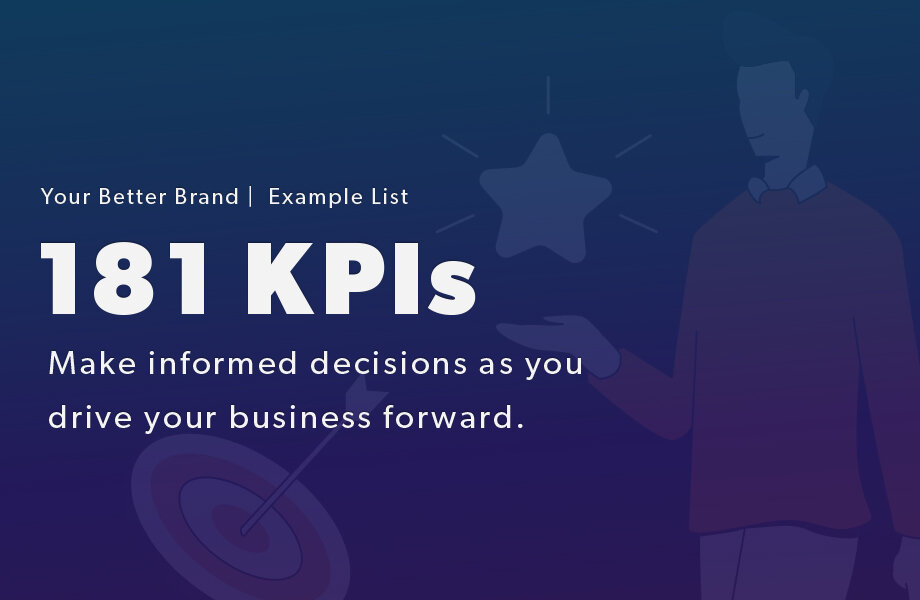Example list of 181 impactful KPIs for your business.
Example List of 181 KPIs

What are KPIs
Choosing The Right KPIs
Sales KPIs:
2. Monthly sales
3. Monthly new customers
4. Monthly new leads
5. Number of qualified leads
6. Resources spent on one non-paying client
7. Resources spent on one paying client
8. Customer lifetime value
9. customer profitability
10. Lead-to-sale conversion rate
11. Cost per lead by channel
12. Cost of a new client by channel
13. Hourly, daily, weekly, monthly, quarterly, and annual sales
14. Average conversion time
15. Lead-to-close rate: all channels
16. Customer turnover rate
17. Customer engagement level
18. Number of abandoned shopping carts
19. Shopping cart abandonment rate
20. Number of monthly quotes
21. Average purchase value
22. Average order value
23. Sales by lead source
24. Inbound calls handled per sales rep
25. Outbound calls handled per sales rep
26. Average annual sales volume per customer
27. Average monthly sales volume per customer
28. Value of returned goods and warranties
29. Percentage of total sales from existing customers
30. Monthly sales quota attainment
31. Sales quota attainment by sales rep
Financial KPIs:
33. Operating cash flow (OCF)
33. Working capital
34. Current accounts receivable
35. Current accounts payable
36. Accounts payable turnover
37. Accounts receivable turnover
38. Accounts payable process cost
39. Budget variance
40. Budget creation cycle time
41. Line items in budget
42. Earnings before interest, tax, depreciation and amortization EBITDA
43. Vendor expenses
44. Payment error rate
45. Finance error report
46. Debt to equity ratio
47. Return on equity
48. Cost of managing business
Project Management KPIs:
50. Actual cost (AC)
51. Earned value (EV)
52. Cost variance (CV) Planned budget vs. Actual budget
53. Schedule variance (SV)
54. Schedule performance index (SPI)
55. Cost performance index (CPI)
56. Planned hours of work vs. Actual hours of work
57. Overdue project tasks / crossed deadlines
58. Percent of overdue project tasks
59. Missed Milestones
60. Percentage of projects completed on time
61. Percentage of canceled projects
62. Percentage of projects on budget
63. Number of budget iterations
64. Percentage of tasks completed
65. Cost of managing processes
66. Return on investment (ROI)
Marketing KPIs:
68. Qualified leads per month
69. Marketing qualified leads (MQL)
70. Sales-accepted leads (SAL)
71. Sales qualified leads (SQL)
72. Cost per lead generated
73. Net promoter score
74. Cost per conversion
75. Cost per conversion by channel
76. Average time of conversion
77. Retention rate
78. Attrition rate
79. Monthly website traffic
80. Unique Monthly Visitors
81. Unique Daily Visitors
82. Traffic from organic search
83. Returning vs. new visitors
84. Visits per channel
85. Average time on page
86. Click-through rate
87. Pages per visit
88. Conversion rate for call-to-action content
89. Conversion rate individual call-to-action
90. Inbound links to website
91. Traffic & Leads from organic search
92. Online share of voice OSOV
93. Keywords in top 10 SERP
94. Rank increase of target keywords
95. Conversion rate per keyword
96. Page authority
97. Google PageRank
98. Leads from paid advertising
99. Conversion from paid advertising
100. Number of monthly PPC campaigns
101. Number of daily PPC campaigns
102. Cost per acquisition (CPA)br> 103. Cost per conversion (CPC)
104. Click-through rate on PPC advertising
105. Traffic from social media
106. Number of leads from social media
107. Number of conversions from social media
108. Conversion rate for social media leads
109. Social media mentions
110. Social media ROI
111. Managed audience size
112. Engagement rate
113. Number of monthly blog visits
114. Blog articles published per month
115. E-books published per month
116. Infographics published per month
117. ROI per content type
118. Web traffic from PR campaigns
119. Leads from PR campaigns
120. Conversions from PR campaigns
121. Number Overall Interactions from PR campaigns
122. Media impressions from PR campaigns
123. ROI from PR campaigns
Operational Performance KPIs:
125. Capacity Utilisation Rate (CUR)
126. Process Waste Level
127. Order Fulfilment Cycle Time
128. Delivery In Full, On Time (DIFOT) Rate
129. Inventory Shrinkage Rate (ISR)
130. Project Schedule Variance (PSV)
131. Project Cost Variance (PCV)
132. Earned Value (EV) Metric
133. Innovation Pipeline Strength (IPS)
134. Return on Innovation Investment (ROI2)
135. Time to Market
136. First Pass Yield (FPY)
137. Rework Level
138. Quality Index
139. Overall Equipment Effectiveness (OEE)
140. Process or Machine Downtime Level
141. First Contact Resolution (FCR)
Employee Performance KPIs:
143. Revenue Per Employee
144. Employee Satisfaction Index
145. Employee Engagement Level
146. Staff Advocacy Score
147. Employee Churn Rate
148. Average Employee Tenure
149. Absenteeism Bradford Factor
150. 360-Degree Feedback Score
151. Salary Competitiveness Ratio (SCR)
152. Time to Hire
153. Training Return on Investment
Environmental and Social Sustainability KPIs:
155. Water Footprint
156. Energy Consumption
157. Saving Levels Due to Conservation and Improvement Efforts
158. Supply Chain Miles
159. Waste Reduction Rate
160. Waste Recycling Rate
161. Product Recycling Rate
Customer Service KPIs:
163. Customer Retention Rate
164. Customer Satisfaction Index
165. Customer Profitability Score
166. Customer Lifetime Value
167. Customer Turnover Rate
168. Customer Engagement
169. Customer Complaints
Bonus: Financial KPIs:
171. Total Shareholder Return (TSR)
172. Economic Value Added (EVA)
173. Return on Capital Employed (ROCE)
174. Return on Assets (ROA)
175. Return on Equity (ROE)
176. Debt-to-Equity (D/E) Ratio
177. Cash Conversion Cycle (CCC)
178. Working Capital Ratio
179. Operating Expense Ratio (OER)
180. CAPEX to Sales Ratio
181. Price Earnings Ratio (P/E Ratio)
Remember, select KPI’s that show whether you’re getting closer to accomplishing your goals or are not. Stay away from “Fluff KPIs.” Fluff KPIs are what you use when you don’t know how to measure actual value. They’re quick and easy to find but give no insight into where your business stands or what needs attention.
